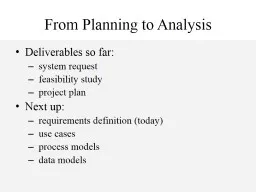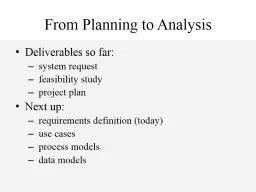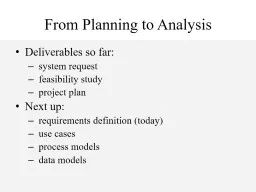PPT-A System Analysis Study
Author : faustina-dinatale | Published Date : 2016-02-25
Comparing Reverse Engineered Combinatorial Testing to Expert Judgment Atlee M Cunningham Jr Jon Hagar Ryan J Holman Lockheed Martin Jondhagarlmcocom Agenda Introduce
Presentation Embed Code
Download Presentation
Download Presentation The PPT/PDF document "A System Analysis Study" is the property of its rightful owner. Permission is granted to download and print the materials on this website for personal, non-commercial use only, and to display it on your personal computer provided you do not modify the materials and that you retain all copyright notices contained in the materials. By downloading content from our website, you accept the terms of this agreement.
A System Analysis Study: Transcript
Comparing Reverse Engineered Combinatorial Testing to Expert Judgment Atlee M Cunningham Jr Jon Hagar Ryan J Holman Lockheed Martin Jondhagarlmcocom Agenda Introduce the trade study space the F16 and Combinatorial Test CT problem. PCA Limitations of LDA Variants of LDA Other dimensionality reduction methods brPage 2br CSCE 666 Pattern Analysis Ricardo Gutierrez Osuna CSETAMU Linear discriminant analysis two classes Objective LDA seeks to reduce dimensionality while preserv Software Architectures. 2. What Is Architectural Analysis?. Architectural analysis. is the activity of discovering important system properties using the system. ’. s architectural models.. Early, useful answers about relevant architectural aspects. CSUB. Yong Choi. 2. Systems Analysis Phases. Scope Definition Phase : . WHAT PROBLEM. Is the project worth looking at ? . Problem Analysis Phase: . WHAT ISSUES. Is the new system worth . building?. Requirements Analysis Phase: . Deliverables so far:. system request. feasibility study. project plan. Next up:. requirements definition (today). use cases. process models. data models. Systems Analysis and. Information Gathering. approaches, phases and requirements discovery. Karolina . Muszyńska. Based on http://www.csun.edu/~dn58412/IS431/IS431_SP13.html. Systems Analysis vs. Systems Design. Systems Analysis Phases and Tasks. Deliverables so far:. system request. feasibility study. project plan. Next up:. requirements definition (today). use cases. process models. data models. Systems Analysis and. Information Gathering. Ian Fisk, . Maria Girone, . Alexei . Klimentov. . Introduction. This talk is about an initiative between IT-ES, CMS and ATLAS for investigating commonalities in analysis frameworks . Environment . highly resource constrained and likely to be more so in the . Deliverables so far:. system request. feasibility study. project plan. Next up:. requirements definition (today). use cases. process models. data models. Systems Analysis and. Information Gathering. Comparing Reverse Engineered . Combinatorial Testing to Expert Judgment. Atlee M. Cunningham, Jr., Jon Hagar, Ryan . J. Holman. Lockheed Martin. Jon.d.hagar@lmco.com. Agenda. Introduce the trade study space: the F16 and Combinatorial Test (CT) problem. Positive or negative movie review?. unbelievably . disappointing . Full of . zany characters and richly applied satire, and some great plot . twists. this is the greatest screwball comedy ever . filmed. Population and family based association study on TPH1, TPH2 and ITGB3 genes indicate serotonergic system involvement in autism spectrum disorder Asem Surindro Singh, Ph. D. Email: asemsuren@gmail.com Objective. Understand the philosophy of meta-analysis and its contribution to epidemiology and science.. Understand the limitations of meta-analysis. Introduction. Systematic quantitative integration of results . Outline. Introduction. Two review papers. Quality control (. MetaQC. ). Meta-analysis for detecting differentially expressed genes (. MetaDE. ). Meta-analysis for detecting pathways (. MetaPath. ). 1. Introduction. omics. data. 4/13/2012. Information integration of . omics. data can mean a broad range of topics.. Integrate freshly generated data with existing knowledge (biological knowledge, database and inference tools).
Download Document
Here is the link to download the presentation.
"A System Analysis Study"The content belongs to its owner. You may download and print it for personal use, without modification, and keep all copyright notices. By downloading, you agree to these terms.
Related Documents














